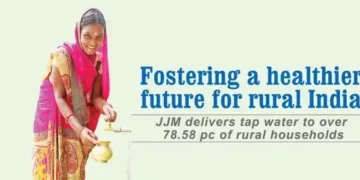THE Jal Jeevan Mission (JJM) was launched by Prime Minister Narendra Modi on August 15, 2019, with the ambitious goal of providing tap water supply to every rural household by 2024.
At the time of its inception, only 3.23 crore (17 pc) of rural households had tap water connections. The mission aims to bridge this gap by providing nearly 16 crore additional households with tap water by 2024, ensuring the functionality of existing water supply systems, and directly benefiting over 19 crore rural families.
Jal Jeevan Mission also strives for the freedom of women from centuries-old drudgery of fetching water for the household, and improving their health, education and socio- economic condition. The mission also implements source sustainability measures as mandatory elements, such as recharge and reuse through greywater management, water conservation and rainwater harvesting.
As of October 6, the mission has successfully provided tap water connections to 11.95 crore additional rural households, bringing the total coverage to more than 15.19 crore households, which accounts for 78.58 pc of all rural households.
Objectives, impact
The broad objectives of the Jal Jeevan Mission include providing functional household tap connection (FHTC) to every rural household; prioritising FHTC provision in drought-prone regions, desert areas, and SAGY villages; ensuring functional tap connections in schools, Anganwadi centers, gram panchayat buildings etc; monitoring the functionality of tap connection; promoting voluntary ownership among the local community; and ensuring the sustainability of water supply systems.
The implementation of Jal Jeevan Mission has brought significant improvements in rural life, as highlighted by several national and international institutions. The World Health Organisation (WHO) estimates that achieving JJM’s goals will save over 5.5 crore hours daily, primarily for women, otherwise spent collecting water. It also projects that ensuring safely managed drinking water for all households in India could prevent nearly 400,000 deaths from diarrheal diseases.
The Indian Institute of Management Bangalore, in partnership with the International Labour Organisation (ILO), estimates that JJM will generate 59.9 lakh person-years of direct and 2.2 crore person-years of indirect employment during its capital expenditure phase. Additionally, the operation and maintenance phase could generate 13.3 lakh person-years of direct employment.
Quality assurance
To ensure the long-term sustainability of infrastructure, JJM emphasises quality construction and materials, with third-party inspections before payments are made. The mission also incorporates advanced technologies such as sensor-based IoT solutions for water supply measurement, AADHAR linking for targeted delivery, and geo-tagging of assets.
Transparency and effective monitoring are ensured through the online ‘JJM dashboard’ and mobile app, providing real-time progress updates. To instill a sense of ownership among rural communities, JJM emphasises village-level planning and community participation in all water supply decisions.
The mission faces several challenges, such as a lack of dependable water sources in certain areas, groundwater contamination, uneven geographical terrain, scattered rural habitations, and delays in obtaining statutory clearances etc. To address these challenges, the Government has taken various steps, including financial assistance, appointment of nodal officers, establishment of state and district programme management units, and the implementation of the ‘Nal Jal Mitra Programme’ to ensure the availability of skilled personnel at the village level.
Catch the Rain
Recognising the importance of sustainable water management, the Jal Shakti Abhiyan: Catch the Rain (JSA: CTR) campaign was launched in 2019, focusing on water conservation through people’s participation. In 2023, the campaign emphasised ‘Source Sustainability for Drinking Water,’ and in 2024, it was implemented with the theme ‘Nari Shakti se Jal Shakti,’ highlighting the crucial role of women in water conservation.
The latest status of the Har Ghar Jal initiative shows that 165 districts have reported their progress (indicating that tap water is being supplied to all households, schools, and Anganwadi centres as confirmed by the water supply department), with 97 of them certified (Gram Sabha resolution passed after verifying the water supply).
A total of 11 states/UTs, which include, Goa, A&N Islands, Dadra Nagar Haveli & Daman Diu, Haryana, Telangana, Puducherry, Gujarat, Himachal Pradesh, Punjab, Mizoram, and Arunachal Pradesh have provided tap water connection to all rural households (100 per cent) in the respective state/UT. Till date 9,29,805 schools and 9,66,805 Anganwadi centres have tap water supply.
Remarkable strides
In conclusion, the Jal Jeevan Mission has made remarkable strides toward achieving its ambitious goal of providing every rural household in India with a functional tap water connection. With over 15.19 crore households, numerous schools, and Anganwadi centres now benefitting from reliable access to clean water, the mission is significantly improving the quality of life in rural areas.
This initiative not only addresses water scarcity but also empowers communities, particularly women, by alleviating the burden of water collection and enhancing public health outcomes. The mission’s emphasis on community participation, sustainability, and technological innovation underscores its long-term vision. As the mission progresses, it continues to transform lives and foster a healthier, more equitable future for rural India.
































